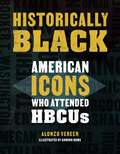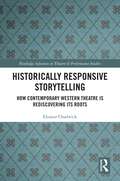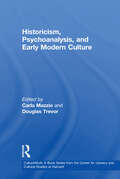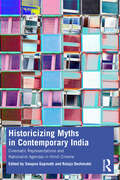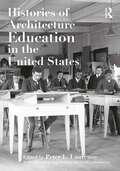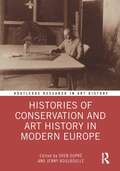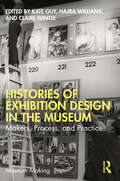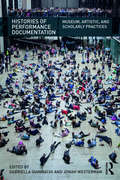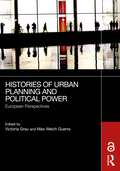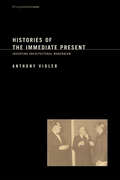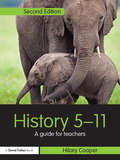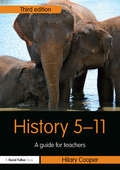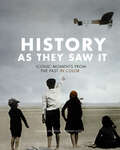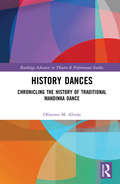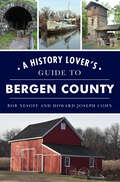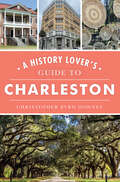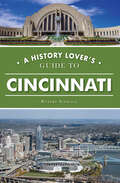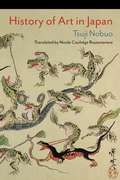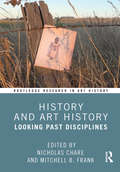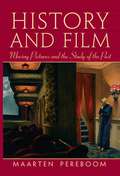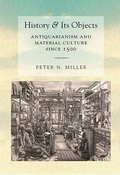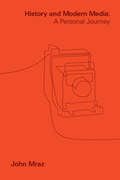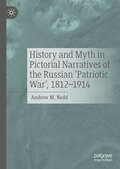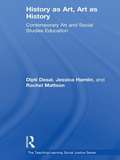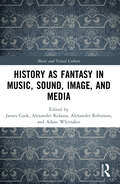- Table View
- List View
Historically Black: American Icons Who Attended HBCUs
by Alonzo VereenA vibrant collection of biographies and illustrated portraits that capture the brilliance of more than thirty American icons, Historically Black is a celebration of Black excellence in fields ranging from politics to STEM, sports to pop culture, and more.From the moment the first HBCU was founded in 1837, Black Americans from all walks of life have created collegiate experiences that enrich and transcend mainstream postsecondary education. Today, more than 100 colleges and universities are registered under the HBCU banner and over 200,000 students are enrolled. With a legacy of marching bands, drill teams, choral ensembles, homecoming, and more, attending an HBCU is an emblem of pride and a source of joy. Historically Black documents not only HBCU cultural traditions but also the remarkable stories of former students. HBCU attendees in the book include: Booker T. Washington, James Weldon Johnson, Ida B. Wells-Barnett, W.E.B. Du Bois, Mary McLeod Bethune, Alice Dunbar Nelson, Zora Neale Hurston, Howard Thurman, Langston Hughes, Thurgood Marshall, Bayard Rustin, Dorothy Vaughan, Katherine Johnson, Mary Jackson, Leontyne Price, Martin Luther King, Jr., Toni Morrison, John Lewis, Bob Hayes, Oprah Winfrey, Kamala Harris, Hakeem M. Oluseyi, Taraji P. Henson, Erykah Badu, Stacey Abrams, Ta-Nehisi Coates, Chadwick Boseman, Hebru Brantley, Ibram X. Kendi, J.R. Smith, Megan Thee Stallion, and Mo&’ne Davis.
Historically Responsive Storytelling: How Contemporary Western Theatre is Rediscovering its Roots (Routledge Advances in Theatre & Performance Studies)
by Eleanor ChadwickThis book explores the notion that the emergent language of contemporary theatre, and more generally of modern culture, has links to much earlier forms of storytelling and an ancient worldview. This volume looks at our diverse and amalgamative theatrical inheritance and discusses various practitioners and companies whose work reflects and recapitulates ideas, approaches, and structures original to theatre’s ritual roots. Drawing together a range of topics and examples from the early Middle Ages to the modern day, Chadwick focuses in on a theatrical language which includes an emphasis on the psychosomatic, the non-linear, the symbolic, the liminal, the collective, and the sacred. This interdisciplinary work draws on approaches from the fields of anthropology, philosophy, historical and cognitive phenomenology, and neuroscience, making the case for the significance of historically responsive modes in theatre practice and more widely in our society and culture.Eleanor
Historicism, Psychoanalysis, and Early Modern Culture (CultureWork: A Book Series from the Center for Literacy and Cultural Studies at Harvard)
by Douglas Trevor Carla MazzioFirst published in 2000. Did people in early modern Europe have a concept of an inner self? Carla Mazzio and Douglas Trevor have brought together an outstanding group of literary, cultural, and history scholars to answer this intriguing question. Through a synthesis of historicism and psychoanalytic criticism, the contributors explore the complicated, nuanced, and often surprising union of history and subjectivity in Europe centuries before psychoanalytic theory. Addressing such topics as "fetishes and Renaissances," "the cartographic unconscious," and "the topographic imaginary," these essays move beyond the strict boundaries of historicism and psychoanalysis to carve out new histories of interiority in early modern Europe.
Historicizing Myths in Contemporary India: Cinematic Representations and Nationalist Agendas in Hindi Cinema
by Swapna Gopinath Rutuja DeshmukhThis book examines cinematic practices in Bollywood as narratives that assist in shaping the imagination of the age, especially in contemporary India. It examines historical films released in India since the new millennium and analyses cinema as a reflection of the changing socio-political and economic conditions at any given period. The chapters in Historicizing Myths in Contemporary India: Cinematic Representations and Nationalist Agendas in Hindi Cinemas also illuminate different perspectives on how cinematic historical representations follow political patterns and market compulsions, giving precedence to a certain past over the other, creating a narrative suited for the dominant narrative of the present. From Mughal-e-Azam to Padmaavat, and Bajirao Mastani to Raazi, the chapters show how creating history out of myths validate hegemonic identities in a rapidly evolving Indian society. The volume will be of interest to scholars of film and media studies, literature and culture studies, and South Asian studies.
Histories of Architecture Education in the United States
by Peter L. LaurenceHistories of Architecture Education in the United States is an edited collection focused on the professional evolution, experimental and enduring pedagogical approaches, and leading institutions of American architecture education. Beginning with the emergence of architecture as a profession in Philadelphia and ending with the early work, but unfinished international effort, of making room for women and people of color in positions of leadership in the field, this collection offers an important history of architecture education relevant to audiences both within and outside of the United States. Other themes include the relationship of professional organizations to educational institutions; the legacy of late nineteenth-century design concepts; the role of architectural history; educational changes and trans-Atlantic intellectual exchanges after WWII and the Cold War; the rise of the city and urban design in the architect’s consciousness; student protests and challenges to traditional architecture education; and the controversial appearance of environmental activism. This collection, in other words, provides a relevant history of the present, with topics of concern to all architects studying and working today.
Histories of Conservation and Art History in Modern Europe (Routledge Research in Art History)
by Sven DupréThis book traces the development of scientific conservation and technical art history. It takes as its starting point the final years of the nineteenth century, which saw the establishment of the first museum laboratory in Berlin, and ground-breaking international conferences on art history and conservation held in pre-World-War-I Germany. It follows the history of conservation and art history until the 1940s when, from the ruins of World War II, new institutions such as the Istituto Centrale del Restauro emerged, which would shape the post-war art and conservation world. The book will be of interest to scholars working in art history, conservation history, historiography, and history of science and humanities.
Histories of Exhibition Design in the Museum: Makers, Process, and Practice (Museum Making)
by Claire Wintle Hajra Williams Kate GuyHistories of Exhibition Design in the Museum: Makers, Process, and Practice offers a new model for understanding exhibition design in museums as a human and material process. It presents diverse case studies from around the world, from the nineteenth century to the recent past. It moves beyond the power of the finished exhibition over both objects and visitors to highlight historic exhibition making as an ongoing task of adaptation, experimentation, and interaction that involves intellectual, creative, and technical choices. Attentive to hierarchies of ethnicity, race, class, gender, sexuality, and ableism that have informed exhibition design and its histories, the volume highlights the labour involved in making museum exhibitions. It presents design as filled with personal and professional demands on the body, senses, and emotions. Contributions from historians, anthropologists, and exhibition makers focus on histories of identity, collaboration, and hierarchy ‘behind the scenes’ of the museum. They argue for an emphasis on the everyday objects of museum design and the importance of a diverse range of actors within and beyond the museum, from carpenters and label writers to volunteers and local communities. Histories of Exhibition Design in the Museum offers scholars, students, and professionals working across the museum and design sectors insight into how past methods still influence museums today. Through a postcolonial and decolonial lens, it reveals the lineage of current processes and supports a more informed contemporary practice.
Histories of Performance Documentation: Museum, Artistic, and Scholarly Practices
by Gabriella Giannachi Jonah WestermanHistories of Performance Documentation traces the many ways in which museums have approached performance works from the 1960s onwards, considering the unique challenges of documenting live events. From hybrid and interactive arts, to games and virtual and mixed reality performance, this collection investigates the burgeoning role of the performative in museum displays. Gabriella Giannachi and Jonah Westerman bring together interviews and essays by leading curators, conservators, artists and scholars from institutions including MoMA, Tate, SFMOMA and the Whitney, to examine a range of interdisciplinary practices that have influenced the field of performance documentation. Chapters build on recent approaches to performance analysis, which argue that it should not focus purely on the live event, and that documentation should not be read solely as a process of retrospection. These ideas create a radical new framework for thinking about the relationship between performance and its documentation—and how this relationship might shape ideas of what constitutes performance in the first place.
Histories of Urban Planning and Political Power: European Perspectives
by Victoria GrauUrban planning has always been a preeminent instrument of political power. In this volume, contributions from Europe and Latin America provide insight into the functions of planning under very different political and societal constellations over the last hundred years: dictatorships, parliamentary democracies, and illiberalism; capitalism and state socialism; state interventionism and neoliberalism; societies in times of peace and societies marked by colonial, civil, world, or cold wars.The dictatorships of the 1920s and 1930s made extensive use of the potential of planning for economic growth, for brutal repression, but also for the integration of certain population groups and as an effective means of propaganda. The legacy of these dictatorships still characterizes many European cities today and confronts planning with complex tasks. Dictatorial state socialism planned to establish a new social order with a particular technocratic rationality, which did not, however, cancel completely the tendential autonomy of the professional planning sphere. Parliamentary democracies and illiberal regimes have developed specific new practices of using planning to rebuild cities in the interests of neoliberal economic growth and populistic legitimization of power.Histories of Urban Planning and Political Power takes the next steps in significantly expanding our understanding of planning and politics. The book will be of interest to students and scholars of urbanism, urban/town planning, spatial planning, spatial politics, urban development, urban policies, and planning history and European history of the 20th century.The Open Access version of this book, available at http://www.taylorfrancis.com, has been made available under a Creative Commons Attribution-Non Commercial-No Derivatives (CC-BY-NC-ND) 4.0 license.
Histories of the Immediate Present: Inventing Architectural Modernism (Writing Architecture)
by Anthony VidlerHow the different narratives of four historians of architectural modernism—Emil Kaufmann, Colin Rowe, Reyner Banham, and Manfredo Tafuri—advanced specific versions of modernism. Architecture, at least since the beginning of the twentieth century, has suspended historical references in favor of universalized abstraction. In the decades after the Second World War, when architectural historians began to assess the legacy of the avant-gardes in order to construct a coherent narrative of modernism's development, they were inevitably influenced by contemporary concerns. In Histories of the Immediate Present, Anthony Vidler examines the work of four historians of architectural modernism and the ways in which their histories were constructed as more or less overt programs for the theory and practice of design in a contemporary context. Vidler looks at the historical approaches of Emil Kaufmann, Colin Rowe, Reyner Banham, and Manfredo Tafuri, and the specific versions of modernism advanced by their historical narratives. Vidler shows that the modernism conceived by Kaufmann was, like the late Enlightenment projects he revered, one of pure, geometrical forms and elemental composition; that of Rowe saw mannerist ambiguity and complexity in contemporary design; Banham's modernism took its cue from the aspirations of the futurists; and the “Renaissance modernism” of Tafuri found its source in the division between the technical experimentation of Brunelleschi and the cultural nostalgia of Alberti. Vidler's investigation demonstrates the inevitable collusion between history and design that pervades all modern architectural discourse—and has given rise to some of the most interesting architectual experiments of the postwar period.
History 5-11: A guide for teachers
by Hilary CooperHistory 5-11 addresses the key issues surrounding the teaching of history in the primary curriculum. With an emphasis on the importance of learning about the past through the processes of historical enquiry, this textbook will be an invaluable resource to all trainee and practising primary teachers interested in teaching history in an accessible, dynamic and above all enjoyable way. This fully updated second edition highlights: Examples of good practice; Meaningful assessment and record keeping; Planning for progression and differentiation; The primary to secondary transition; Cross-curricular approaches to history. This book also analyses the most recent and salient reports concerning primary education, including the 2011 Ofsted report History for All, the Historical Association Primary Survey 2011 and the findings of the Cambridge Review. It contains case studies, lesson planning guidance and methods to develop pupils’ historical understanding as well as offering creative and innovative ways to teach the subject of history in the primary classroom.
History 5–11: A Guide for Teachers (Primary 5-11 Series)
by Hilary CooperNow in its third edition, History 5-11 aims to make teaching about the past exciting and stimulating for both teachers and children. Focusing on the English National Curriculum for History (2013), and with an emphasis on the importance of learning about the past through the processes of historical enquiry, History 5-11 contains case studies, lesson planning guidance and methods to develop pupils‘ historical understanding. It offers creative and innovative ways to teach the subject of history, refreshing teachers‘ confidence in teaching the 2013 curriculum, and is illustrated by new case studies and research. This fully updated third edition includes: References to the 2013 National Curriculum, its aims and purposes, and its content and processes for Key Stages 1 & 2 Guidance on making local, national and global connections between societies over time Planning for assessment and progression New research and illustrative case studies New sections on local history and links to oracy Updates to all existing chapters Reflection on practice and research: undergraduate, Masters level and PhD. This textbook is an invaluable resource to all trainee and practising primary teachers interested in teaching history in an accessible, dynamic and above all, enjoyable way.
History As They Saw It: Iconic Moments from the Past in Color
by Wolfgang Wild Jordan Lloyd“Why do we think of history in black and white? Here is the past in vibrant color . . . a remarkable book that re-imagines a century.” —Aspen Daily NewsThe past didn’t actually happen in black and white, as we’re reminded by this collection of restored and colorized historic photos from the mid-19th to mid-20th century. This revolutionary photography collection is as close to time travel as it gets. Featuring 120 historic black-and-white photographs thoroughly restored and rendered in color, this book illuminates some of the most iconic moments in history, from the sinking of the Titanic to the construction of the Golden Gate Bridge. Brought to life with vibrant color, these incredible images effectively blur the distinction between past and present, making history feel more real and and bringing it within arm’s reach. With a timeline spanning more than 100 years, from 1839 to 1949, this unique collection will amaze history and photography buffs alike, offering new perspectives on significant moments of the nineteenth and twentieth centuries.
History Dances: Chronicling the History of Traditional Mandinka Dance (Routledge Advances in Theatre & Performance Studies)
by Ofosuwa M. AbiolaThe field of history is founded on the interrogation of written documents from the past. However, culture is the center of life in Africa. As a result, in the past – and to a degree in the present – the process for documenting events in Africa was not written, it was performed. History Dances: Chronicling the History of Traditional Mandinka Dance argues that a wealth of information is housed within traditional Mandinka dance and, consequently, the dances can be used as an African-derived primary source for writing African history. Ofosuwa M. Abiola highlights the overall value of studying Mandinka dance history specifically, and African dance history generally, as well as addressing the issue of scarcity with regard to primary sources for writing African history. History Dances proves to be a vital read for both undergraduate students and scholars in the fields of dance history, African history, performance studies, and cultural anthropology.
History Lover's Guide to Bergen County, A (Landmarks)
by Bob Nesoff Howard Joseph CohnFrom the crossroads of the American Revolution to the construction of the George Washington Bridge, New Jersey's Bergen County has a history that has shaped not only the metropolitan area, but the nation itself. Featuring narratives of key historical moments, legendary personalities and fascinating landmarks, this guide to Bergen County's past is essential for any resident or visitor alike. Take a copy along as you traverse the county and discover the historic sites within and the stories behind them. Authors Bob Nesoff and Howard Joseph Cohn take readers on a fascinating journey through Bergen County's incredible past.
History Lover's Guide to Charleston, A (History & Guide)
by Christopher Byrd DowneyFounded in 1670, Charleston is among the oldest cities in the nation and site of some of the most pivotal events in American history. Explore the city and discover the Old Exchange and Provost Dungeon where South Carolina ratified the U.S. Constitution in 1788. Visit beautiful Rainbow Row and learn the true history of this most iconic of Charleston sites. Tour the city's oldest church edifice at St. Michael's Church, which first opened for services in 1761. Join historian and author Christopher Byrd Downey for a guided tour of nearly one hundred historic Charleston sites tailor-made for the history lover.
History Lover's Guide to Cincinnati, A (History & Guide)
by Robert SchrageA tour of the Queen City's rich heritage One of the oldest cities in the Midwest, Cincinnati has history in its bones. In the 1800s, the city was often styled the "Paris of America" due in part to ambitious architectural projects like the Music Hall, Cincinnatian Hotel, and city hall. Many of these historical structures still exist. The city also has sundry links to American presidents, whose stories can still be seen if you know where to look. Thriving destinations like Over the Rhine and Findlay Market provide glimpses of Cincinnati as it once was and how it is today. Offering something for native and visitor alike, author Robert Schrage leads a trip through the past and present of one of the nation's most historic cities.
History Of Art In Japan
by Nicole Rousmaniere Nobuo TsujiHistory of Art in Japan is a fully illustrated overview of Japanese art, written by one of Japan's most distinguished art historians. This masterful account of the country's exceptional cultural heritage sheds light on how Japan has nurtured distinctive aesthetics, prominent artists, and movements that have achieved global influence and popularity. A leading authority on Japanese art history, Tsuji Nobuo discusses works ranging from the Jōmon period to contemporary art, from earthenware figurines in 13,000 BCE to manga, anime, and modern subcultures. He explains crucial aspects of Japan's many artistic mediums and styles--including paintings, ukiyo-e, ceramics, sculpture, armor, gardens, and architecture--covering thousands of years. Drawing on newly discovered archaeological findings and the latest research, the book examines Japanese art in various contexts, including Buddhist and religious influences, aristocratic and popular aesthetics, and interactions with the world. Generously illustrated with hundreds of full-color images, maps, and figures, History of Art in Japan is an indispensable resource for all those interested in this multifaceted history, illuminating countless aspects of Japanese art for scholars and general readers alike.
History and Art History: Looking Past Disciplines (Routledge Research in Art History)
by Edited by Nicholas Chare and Mitchell B. FrankThrough a series of cross-disciplinary and interdisciplinary interventions, leading international scholars of history and art history explore ways in which the study of images enhances knowledge of the past and informs our understanding of the present. Spanning a diverse range of time periods and places, the contributions cumulatively showcase ways in which ongoing dialogue between history and art history raises important aesthetic, ethical and political questions for the disciplines. The volume fosters a methodological awareness that enriches exchanges across these distinct fields of knowledge. This innovative book will be of interest to scholars in art history, cultural studies, history, visual culture and historiography.
History and Film: Moving Pictures and the Study of the Past
by Maarten PereboomThe ability to view recorded moving pictures has had a major impact on human culture since the development of the necessary technologies over a century ago. For most of this time people have gone to the movies to be entertained and perhaps edified, but in the meantime television, the videocassette recorder (VCR), the digital versatile disk (DVD) player, the personal computer (desktop and laptop), the internet and other technologies have made watching moving pictures possible at home, in the classroom and just about anywhere else. Today, moving images are everywhere in our culture. Every day, moving picture cameras record millions of hours of activity, human and otherwise, all over the world: your cell phone makes a little video of your friends at a party; the surveillance camera at the bank keeps on eye on customers; journalists’ shoulder-carried cameras record the latest from the war zone; and across the world film artists work on all kinds of movies, from low-budget independent projects to the next big-budget Hollywood blockbuster. Moving pictures have had a great influence on human culture, and this book focuses on using moving images as historical evidence. Studying history means examining evidence from the past to understand, interpret and present what has happened in different times and places. We talk and write about what we have learned, hoping to establish credibility both for what we have determined to be the facts and for whatever meaning or significance we may attach to our reconstruction of the past. Studying history is a scientific process, involving a fairly set methodology. We tend to favor written sources, and we have tended to favor writing as a means of presenting our views of the past. But historians also use all kinds of other documents and artifacts in their work of interpreting the past, including moving pictures.
History and Its Objects: Antiquarianism and Material Culture since 1500
by Peter N. MillerCultural history is increasingly informed by the history of material culture—the ways in which individuals or entire societies create and relate to objects both mundane and extraordinary—rather than on textual evidence alone. Books such as The Hare with Amber Eyes and A History of the World in 100 Objects indicate the growing popularity of this way of understanding the past. In History and Its Objects, Peter N. Miller uncovers the forgotten origins of our fascination with exploring the past through its artifacts by highlighting the role of antiquarianism—a pursuit ignored and derided by modem academic history—in grasping the significance of material culture.From the efforts of Renaissance antiquarians, who reconstructed life in the ancient world from coins, inscriptions, seals, and other detritus, to amateur historians in the nineteenth century working within burgeoning national traditions, Miller connects collecting—whether by individuals or institutions—to the professionalization of the historical profession, one which came to regard its progenitors with skepticism and disdain. The struggle to articulate the value of objects as historical evidence, then, lies at the heart both of academic history-writing and of the popular engagement with things. Ultimately, this book demonstrates that our current preoccupation with objects is far from novel and reflects a human need to reexperience the past as a physical presence.
History and Modern Media: A Personal Journey (Critical Mexican Studies)
by John MrazIn History and Modern Media, John Mraz largely focuses on Mexican photography and his innovative methodology that examines historical photographs by employing the concepts of genre and functions. He developed this method in extensive work on photojournalism; it is tested here through examining two genres: Indianist imagery as an expression of imperial, neo-colonizing, and decolonizing photography, and progressive photography as embodied in worker and laborist imagery, as well as feminist and decolonizing visuality. The book interweaves an autobiographical narrative with concrete research. Mraz describes the resistance he encountered in US academia to this new way of showing and describing the past in films and photographs, as well as some illuminating experiences as a visiting professor at several US universities. More importantly, he reflects on what it has meant to move to Mexico and become a Mexican. Mexico is home to a thriving school of photohistorians perhaps unequaled in the world. Some were trained in art history, and a few continue to pursue that discipline. However, the great majority work from the discipline known as "photohistory" which focuses on vernacular photographs made outside of artistic intentions. A central premise of the book is that knowing the cultures of the past and of the other is crucial in societies dominated by short-term and parochial thinking, and that today's hyper-audiovisuality requires historians to use modern media to offer their knowledge as alternatives to the "perpetual present" in which we live.
History and Myth in Pictorial Narratives of the Russian 'Patriotic War', 1812-1914
by Andrew M. NeddThis book reveals that the visual narrative of the events of the Russian campaign of 1812 was inextricably linked to Russia's search for national identity and helped to form competing definitions of 'Russianness'. No pre-revolutionary military event was more celebrated in Russian literature and art than the ‘Patriotic War of 1812’, during which Napoleon advanced his Grand Armée into Russia, only to retreat months later in defeat as his army faced starvation and capture during the brutal winter. The works of art that retold the story of 1812 extolled virtues that were represented as inherently Russian: courage, resourcefulness, and unity. Furthermore, these values were increasingly contrasted with those of the foreign invader from the west. While the emphasis is largely on academic painting, this book also explores popular media and memorialization in order to reveal the role that images played in the process of constructing identities in nineteenth-century Russia.
History as Art, Art as History: Contemporary Art and Social Studies Education
by Rachel Mattson Dipti Desai Jessica HamlinHistory as Art, Art as History pioneers methods for using contemporary works of art in the social studies and art classroom to enhance an understanding of visual culture and history. The fully-illustrated interdisciplinary teaching toolkit provides an invaluable pedagogical resource—complete with theoretical background and practical suggestions for teaching U.S. history topics through close readings of both primary sources and provocative works of contemporary art. History as Art, Art as History is an experientially grounded, practically minded pedagogical investigation meant to push teachers and students to think critically without sacrificing their ability to succeed in a standards-driven educational climate. Amid the educational debate surrounding rigid, unimaginative tests, classroom scripts, and bureaucratic mandates, this innovative book insists on an alternate set of educational priorities that promotes engagement with creative and critical thinking. Features include: A thought-provoking series of framing essays and interviews with contemporary artists address the pivotal questions that arise when one attempts to think about history and contemporary visual art together. An 8-page, full color insert of contemporary art, plus over 50 black and white illustrations throughout. A Teaching Toolkit covering major themes in U.S. history provides an archive of suggested primary documents, plus discussion suggestions and activities for putting theory into practice. Teaching activities keyed to the social studies and art curricula and teaching standards Resources include annotated bibliographies for further study and lists of arts and media organizations. This sophisticated yet accessible textbook is a must-read resource for any teacher looking to draw upon visual and historical texts in their teaching and to develop innovative curriculum and meaningful student engagement.
History as Fantasy in Music, Sound, Image, and Media (Music and Visual Culture)
by James Cook, Alexander Kolassa, Alexander Robinson, and Adam WhittakerExploring how music is used to portray the past in a variety of media, this book probes the relationship between history and fantasy in the imagination of the musical past. The volume brings together essays from multidisciplinary perspectives, addressing the use of music to convey a sense of the past in a wide range of multimedia contexts, including television, documentaries, opera, musical theatre, contemporary and historical film, videogames, and virtual reality. With a focus on early music and medievalism, the contributors theorise the role of music and sound in constructing ideas of the past. In three interrelated sections, the chapters problematise notions of historical authenticity on the stage and screen; theorise the future of musical histories in immersive and virtual media; and explore sound’s role in more fantastical appropriations of history in television and videogames. Together, they poseprovocative questions regarding our perceptions of ‘early’ music and the sensory experience of distant history. Offering new ways to understand the past at the crossroads of musical and visual culture, this collection is relevant to researchers across music, media, and historical and cultural studies.
